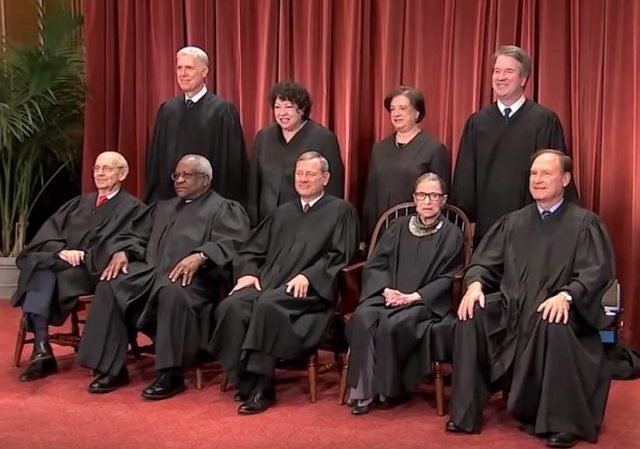Supreme Court: No census citizenship question for now, need clarified agency explanation

In a complicated ruling, the Supreme Court substantially upheld the inclusion of a census question regarding citizenship, but procedurally held that more inquiry was needed into C0mmerce Dept. reasoning in seeking to add the question.
So the bottom line is that there might be a citizenship question, but it’s unclear if there is time to get it resolved under deadlines for printing census forms.
The Syllabus (which is not part of the official Opinion) described the complicated breakdown by Justice:
ROBERTS, C. J., delivered the opinion for a unanimous Court with respect to Parts I and II, and the opinion of the Court with respect to Parts III, IV–B, and IV–C, in which THOMAS, ALITO, GORSUCH, and KAVANAUGH, JJ., joined; with respect to Part IV–A, in which THOMAS, GINSBURG, BREYER, SOTOMAYOR, KAGAN, and KAVANAUGH, JJ., joined; and with respect to Part V, in which GINSBURG, BREYER, SOTOMAYOR, and KAGAN, JJ., joined. THOMAS, J., filed an opinion concurring in partand dissenting in part, in which GORSUCH and KAVANAUGH, JJ., joined. BREYER, J., filed an opinion concurring in part and dissenting in part, in which GINSBURG, SOTOMAYOR, and KAGAN, JJ., joined. ALITO, J., filed an opinion concurring in part and dissenting in part.
Some key portions of the majority opinion:
The Secretary justifiably found the Bureau’s analysis inconclusive. Weighing that uncertainty against the value of obtaining more complete and accurate citizenship data, he determined that reinstating a citizenship question was worth the risk of a potentially lower response rate. That decision was reasonable and reasonably explained, particularly in light of the long history of the citizenship question on the census* * *We now consider the District Court’s determination that the Secretary’s decision must be set aside because it rested on a pretextual basis, which the Government conceded below would warrant a remand to the agency….That evidence showed that the Secretary was determined to reinstate a citizenship question from the time he entered office; instructed his staff to make it happen; waited while Commerce officials explored whether another agency would request census-based citizenship data; subsequently contacted the Attorney General himself to ask if DOJ would make the request; and adopted the Voting Rights Act rationale late in the process. …And yet, viewing the evidence as a whole, we share the District Court’s conviction that the decision to reinstate a citizenship question cannot be adequately explained in terms of DOJ’s request for improved citizenship data to better enforce the VRA. Several points, considered together, reveal a significant mismatch between the decision the Secretary made and the rationale he provided….Altogether, the evidence tells a story that does not match the explanation the Secretary gave for his decision. …We are presented, in other words, with an explanation for agency action that is incongruent with what the record reveals about the agency’s priorities and decisionmaking process. It is rare to review a record as extensive as the one before us when evaluating informal agency action— and it should be. But having done so for the sufficient reasons we have explained, we cannot ignore the disconnect between the decision made and the explanation given.Our review is deferential, but we are “not required to exhibit a naiveté from which ordinary citizens are free.” United States v. Stanchich, 550 F. 2d 1294, 1300 (CA2 1977) (Friendly, J.). The reasoned explanation requirement of administrative law, after all, is meant to ensure that agencies offer genuine justifications for important decisions, reasons that can be scrutinized by courts and the interested public. Accepting contrived reasons would defeat the purpose of the enterprise. If judicial review is to be more than an empty ritual, it must demand something better than the explanation offered for the action taken in this case.In these unusual circumstances, the District Court was warranted in remanding to the agency, and we affirm that disposition. See Florida Power & Light Co. v. Lorion, 470 U. S. 729, 744 (1985). We do not hold that the agency decision here was substantively invalid. But agencies must pursue their goals reasonably. Reasoned decisionmaking under the Administrative Procedure Act calls for an explanation for agency action. What was provided here was more of a distraction.
MORE TO FOLLOW.
Justice Thomas, joined by Gorsuch and Kavanaugh, wrote an concurring in part and dissenting in part opinion:
In March 2018, the Secretary of Commerce exercised his broad discretion over the administration of the decennial census to resume a nearly unbroken practice of asking a question relating to citizenship. Our only role in this case is to decide whether the Secretary complied with the law and gave a reasoned explanation for his decision. The Court correctly answers these questions in the affirmative. Ante, at 11–23. That ought to end our inquiry.The Court, however, goes further. For the first time ever, the Court invalidates an agency action solely because it questions the sincerity of the agency’s otherwise adequate rationale….The Court’s holding reflects an unprecedented departure from our deferential review of discretionary agency decisions. And, if taken seriously as a rule of decision, this holding would transform administrative law. It is not difficult for political opponents of executive actions to generate controversy with accusations of pretext, deceit, and illicit motives.
Will there be a census citizenship question in 2020? That may be determined more by the calendar required for printing and distribution than by subsequent lower court decisions.
It also opens to door to ongoing litigation over newly discovered evidence that goes to motivation.
So this looks like a win for those who don’t want the government to know how many citizens are in the country, and how many of the people answering the census are non-citizens (legally here or otherwise).
CLICK HERE FOR FULL VERSION OF THIS STORY